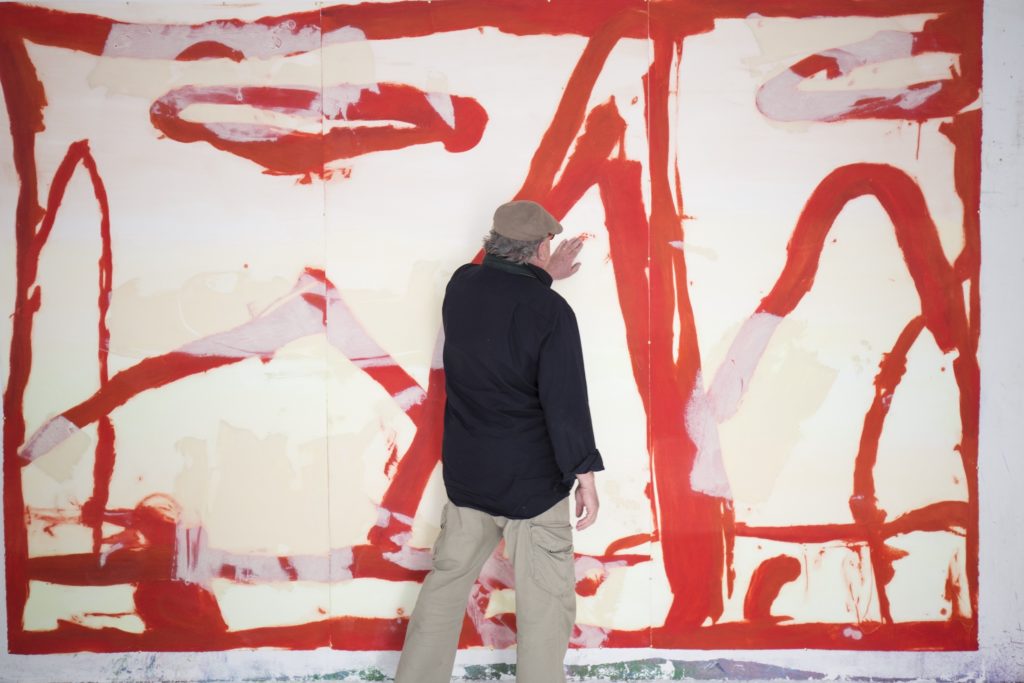
Artist Q&A with Peter Godwin
by Dr Claudia Milburn
Q. I’m interested in what gave you the impetus to show your work after many years being reluctant to do so?
A. I was being patient, waiting for a sense of stability.
Q. Having taught extensively in your career, can you tell me what has been the significance of teaching to you?
A. Great satisfaction in maintaining a particular artistic lineage, e.g. Ingres> Degas> Bromberg>Auerbach. I experienced a lineage in Australia while delaying the stabilisation of my own work.
Q. The project called ‘The Painters Journey’ took you to Hong Kong and Guilin with painter Euan Macleod. Can you tell me about this project and the impact of your experiences?
A. Having spent minimal time in China, I’m still reflecting on that experience in my work a decade on.
Q. Can you talk about the Chinese landscape subject matter of these works and, more broadly, the significance of landscape as subject?
A. The landscape being a different physical experience and trying to rework a cliché. Landscape is not a subject as such, it is an experience.
Q. How have different environments inspired your practice?
A. The word inspiration has always bemused me, I prefer ‘felt’.
Q. You have mentioned that your venture into printmaking was particularly inspired by seeing a series of large-scale prints by Howard Hodgkin. Can you talk about the impression these works had on you?
A. Howard’s work is by a painter through and through, never shallow even when minimal. His work breathes similarly to Turner’s watercolours, rare I feel for an English painter and the works demanding scale.
Q. How do the processes of printmaking and painting relate to each other in your work?
A. The carborundum process is very painterly as sugar lift is in intaglio etching.
Q. These prints have the restraint of single focused colour, or two colours accompanied by white – can you talk about this restraint of colour palette?
A. I wanted the drawing to be paramount not the subject or sense of depiction.
Q. Many of these prints are of vast immersive scale. What is the significance of working at this scale to you?
A. Because I could, the mountains were towers, again they were ’felt’.
Q. Who or what has been your greatest influence as an artist? Which artists have most inspired your practice, both in painting and in printmaking?
A. My major artistic influence as a student was a Scottish born painter, Ian Fairweather, I was not alone in responding to his work. Also the work of Australian painter, (English born), Tony Tuckson. It’s interesting that the two painters broke free of their formal culture and landscape when experiencing Australia’s informal cultures and landscape, read indigenous. – I might acknowledge painters I respect and admire but they have never inspired me, I would also mention poets in the same vein.
Q. What for you are the desired essential qualities of image-making?
A. Self-belief mixed with anxiety.
Q. What are the latest developments in your work?
A. My last painting and the unknown.
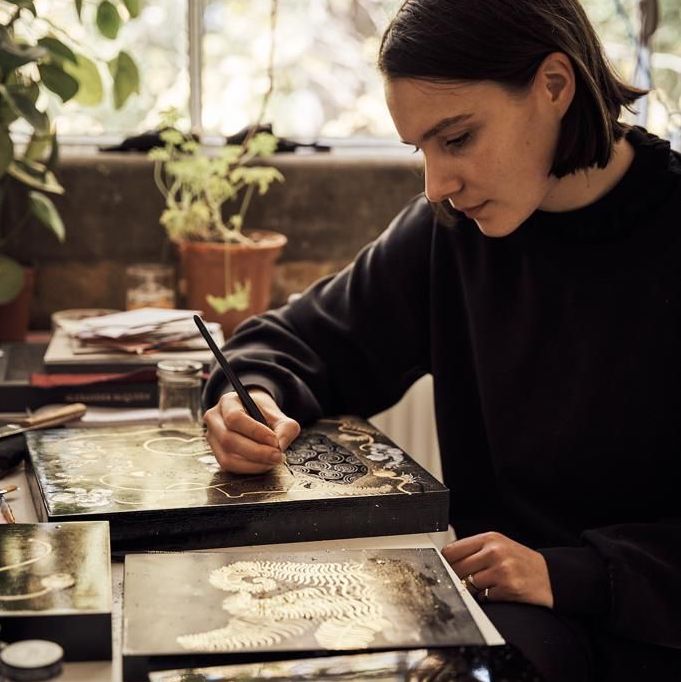
Small Worlds: On Beatrix Potter and Tuesday Riddell
by Anna Souter
In 1896, Beatrix Potter wrote in her diary: “We as outsiders express a pleasing, fresh irreverence for leading botanical authorities, it really does seem very impertinent, but the [facts] are there. It may just be that one sees them because one has an open mind, not in a groove.” Potter believed that working outside the academic tradition and scientific institutions afforded her greater independence of thought and a clearer understanding of flora and fauna; escaping the constraints experienced by the “authorities”, Potter was able to look with an “open mind” to the wonderful possibilities of the natural world.
Of course, working independently was Potter’s only option. When her uncle contrived to show some of her illustrations of fungi to botanists at Kew Gardens, her work was dismissed due to her age and gender; the resident scientists were sceptical that someone in Potters’ position could have come up with plausible theories based on experiments conducted without guidance and in an amateur setting. However, many of the ideas she expresses through her illustrations, such as the symbiotic relationships between many fungi and algal species, are now considered to be more advanced than the botanical knowledge widely held by the male gatekeepers of the science at the time.
Potter did manage to get a (now sadly lost) paper, “On the Germination of the Species of Agaricineae”, read at the Linnean Society soon after this rejection – albeit by a third party as women were not allowed to attend. However, since it seemed impossible that she would gain proper recognition or any degree of financial independence from her work as a naturalist, Potter turned to children’s books, combining narrative and illustration in publications that remain well-loved to this day.
Potter’s illustrative work is unique in how it combines the scientific accuracy of an experienced naturalist with the whimsical inventions of an artist who understands how to appeal to the child’s imagination. Her genius was to dress zoologically correct animals in human clothes, based on a lifetime of study at home and outdoors. For example, when Potter’s publisher complained that the mottled legs emerging from Jeremy Fisher’s red tailcoat and embroidered waistcoat were too yellow, Potter marched over to the offices of Frederick Warne & Co with her pet frog Punch in a jam jar to prove the accuracy of her drawings. She was determined that her books should be lessons in natural history as well as entertainment.
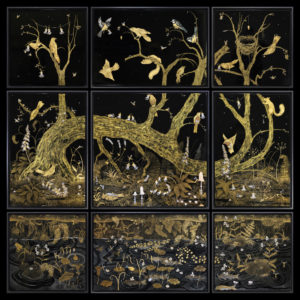 For artist Tuesday Riddell, Beatrix Potter’s small worlds represent a radical continuity between the magical and the real, where close observation of landscapes and ecosystems runs smoothly into a profound re-enchantment with the more-than-human. For Riddell, as for Potter, gaining an intimate knowledge of another being does not strip it of its personhood or its animacy, but rather enhances these qualities and offers a doorway into an imaginative empathy and sense of wonder.
For artist Tuesday Riddell, Beatrix Potter’s small worlds represent a radical continuity between the magical and the real, where close observation of landscapes and ecosystems runs smoothly into a profound re-enchantment with the more-than-human. For Riddell, as for Potter, gaining an intimate knowledge of another being does not strip it of its personhood or its animacy, but rather enhances these qualities and offers a doorway into an imaginative empathy and sense of wonder.
Much of Riddell’s work is closely inspired by the illustrations of animal worlds she encountered in the books of her childhood, with a particular emphasis on the work of Beatrix Potter. Riddell’s images explore the interconnected lives of fungi, insects, birds, and mammals, often in the context of the forest floor or the banks of a body of water. Many of her shimmering, multi-layered images are set in the mysterious hours of darkness and twilight, suggesting a realm of imagined animal encounters, where secret gatherings take place in the absence of human watchers. Like Potter, Riddell creates spaces and relationships which are both fantastical and natural.
Riddell works with japanning, a technique originally developed in the 17th century as an imitation of Asian lacquer work. She learned the process at City & Guilds Art School as part of the Painter-Stainers’ decorative surfaces fellowship, which provides students with specialist training in endangered crafts. For each work, Riddell starts by sanding and polishing a wooden board, before applying between 25 and 30 layers of European lacquer with a brush. The brush marks are removed by sanding and polishing the surface of the lacquer between every three layers.
After the lacquer has cured to a black, mirrored surface, the artist begins to mark out the central composition, which she usually sketches straight onto the board without extensive pre-planning. She marks out key silhouettes of plants, animals, and insects, before using lustre powders to develop the background. She then fills in the silhouettes using pigmented shading and adds detail using gold and silver leaf. Finally, the whole piece is sealed with a layer of shellac or varnish.
For Riddell, there is a parallel to be drawn between endangered crafts and endangered species, and her work attempts to draw attention to both. Her work is as much concerned with the natural world as it is with processes of making; in the midst of the ecological crisis, the delicate, intricate japanning technique reflects the fragility of our ecosystems and our complex relationship with the natural world.
The central work in Tuesday Riddell’s solo presentation at Messum’s London is directly inspired by a visit to Beatrix Potter’s farm, Hilltop, in the Lake District. On a walk through the surrounding countryside, Riddell came across a tree that had fallen beside a small stream, crossing it like a bridge. The tree had begun to sprout new branches growing upwards, resiliently reclaiming vertical growth despite falling to a horizontal position.
Riddell has populated her version of this bowed and twisted – but lively – tree with an ensemble cast of birds, mammals, insects, plants, and mushrooms. These protagonists interact with and respond to each other: blue tits carry off the bell-shaped flowers of a foxglove; a moth rests on the spongey cap of a mushroom; a cocooned caterpillar hangs above a bird’s nest like a baby’s mobile. Although Riddell’s animals are not anthropomorphised in the same way as Potter’s, she similarly allows miniature narratives to emerge within this microcosm, hinting at distinct relationships and personalities among her nonhuman characters.
Riddell’s process involves close observation of wildlife, often in the urban parks, gardens, and waysides surrounding her London home. After absorbing information and picking out small details, she returns to the studio and begins sketching, often drawing directly onto a meticulously prepared gleaming panel. The artist demonstrates an astonishing ability to capture the nuances of other species through working primarily from memory and the imagination.
There is a theatrical quality to Riddell’s work, which combines the naturalistic with the aestheticized in a way that is inspired by the stylised illustrations of children’s books. As in many fairy tales and Victorian stories for children, Riddell’s images contain a potent element of darkness. Her works often incorporate small scenes of conflict, death, or decay, belying initial impressions of perfect harmony. They speak to a widespread sense of unease over the uncanny indifference of nonhuman nature towards human ethics and morality. This can be found, too, in the writings of Beatrix Potter; to the discomfort of many contemporary parents, Potter’s smartly-dressed animals have not been stripped of their natural desire to eat each other, creating conflicts that are resolved only through escape rather than through compromise or moral revelations, as we might expect from children’s stories today.
The shimmering, multifaceted layers of Riddell’s japanned panels appear to shapeshift according to the angle and lighting. This constant metamorphosis infuses the works with a feeling of magic, conjuring another realm hidden a hair’s breadth from our own. Like Beatrix Potter, Riddell shows that there is an enchantment to be found in the comings and goings of everyday nature, from the scamperings of mice to the burrowings of earthworms, from the iridescent flash of a dragonfly’s wing to the quiet rotting of a fallen apple.
For both artists, close observation of the more-than-human is most effective when combined with the radical power of storytelling and the imagination. Riddell’s gleaming, mysterious works speak to the importance of looking at nature with what Beatrix Potter called an “open mind”: a receptiveness to the compelling blend of beauty and horror present in those small worlds that thrive alongside our own, if only we can take the time and look closely enough to notice them.
–
Bibliography:
Annemarie Bilclough (ed.), Beatrix Potter: Drawn to Nature (London, 2022)
Catherine Golden, “Beatrix Potter: Naturalist Artist” in Woman’s Art Journal, Vol. 11, No. 1 (Spring -Summer, 1990), 16-20
Rudolf Schmid, “Beatrix Potter [1866-1943] as a Mycologist: The Period before Peter Rabbit and Friends” in Taxon, Vol. 48, No. 2 (May, 1999), 438-443
Interview by Crafts magazine
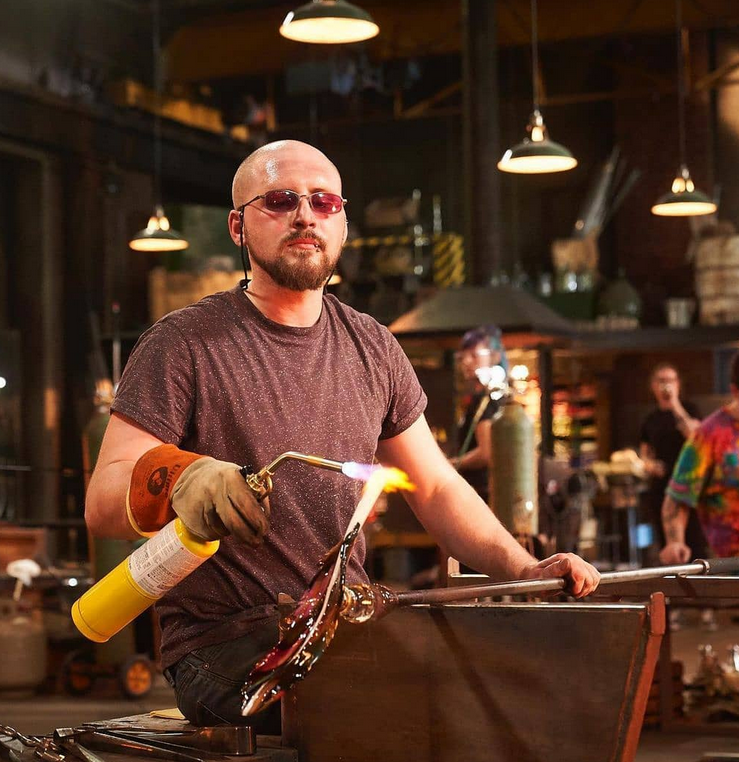
Crafts magazine: How does it feel to have won Blown Away, and what happens next?
Elliot Walker: It’s still sinking in. We actually filmed it a year ago, so I’ve had to keep shtum since then, but the past week has been crazy and I’ve had lots of support. People over here think it’s amazing that someone from the UK has won a US-based show.
As the winner of Blown Away, I was awarded a residency at the Corning Museum, which I’m hoping to do in the autumn, as well as another at the Pittsburgh glass centre. I’m hoping to use those to make work for an exhibition I have planned at the Habatat Galleries in Detroit, the flagship glass gallery in the US.
The American studio glass scene is much bigger than the UK’s. Did you notice a difference?
 Yes, it’s unbelievably different there. One thing I learned is how many institutions they have dedicated to glass – a lot of them with charitable status, so people from underprivileged or challenging backgrounds can go and learn the craft. Glassblowing needs a lot of discipline so I can see how it might change your perspective or your emotional state. A lot of artist there make their work by doing projects with different institutions. I hope people in the UK can start to understand what we’re losing in terms of craft, heritage, history, skills and contemporary practice without publicly funded institutions for glass making.
Yes, it’s unbelievably different there. One thing I learned is how many institutions they have dedicated to glass – a lot of them with charitable status, so people from underprivileged or challenging backgrounds can go and learn the craft. Glassblowing needs a lot of discipline so I can see how it might change your perspective or your emotional state. A lot of artist there make their work by doing projects with different institutions. I hope people in the UK can start to understand what we’re losing in terms of craft, heritage, history, skills and contemporary practice without publicly funded institutions for glass making.
Why do you think you won the competition?
A lot of it was luck – the other contestants were fantastic. I think had the advantage of diversity – because I’m a sculptor more than traditional glassblower, I could come up with different forms quite easily, which gave me an edge.
In your current online exhibition with Messums London you’re showing a new body of work, ‘Plenty’. How does this series draw on traditional still-life paintings?
I’ve been working with glass for 12 years, always experimenting with different techniques. But I’m also influenced by historical works of art. Here, the 3D forms take inspiration from still-life paintings, their composition and depiction of expendable objects.
How do the works comment on our relationship to food?
I’ve been thinking about our idealised conception of food – how the farmed strawberries we eat are so unlike the tiny, seed-covered wild ones. For this show, I have made an enormous strawberry and used a mirroring technique to make it look obscene. Then there’s a triptych of seafood that uses clear glass to comment on the bleaching of coral reefs.
 Could you tell me about the tableware in the display?
Could you tell me about the tableware in the display?
Goblet construction is the height of technical glassmaking, and glassmakers often display many identical ones together. I’ve turned that idea into a sculpture: I’ve made 20 wall-mounted goblets using the traditional reticello technique, but then crushed them down between two concrete blocks until they are distorted, and displayed them on the wall.
The virtual exhibition Elliot Walker: Plenty runs until 13 February. This interview is an updated extract from Crafts magazine’s January/February issue
Interview courtesy of the Crafts Council and Crafts magazine.
Read more about Elliot in The Telegraph
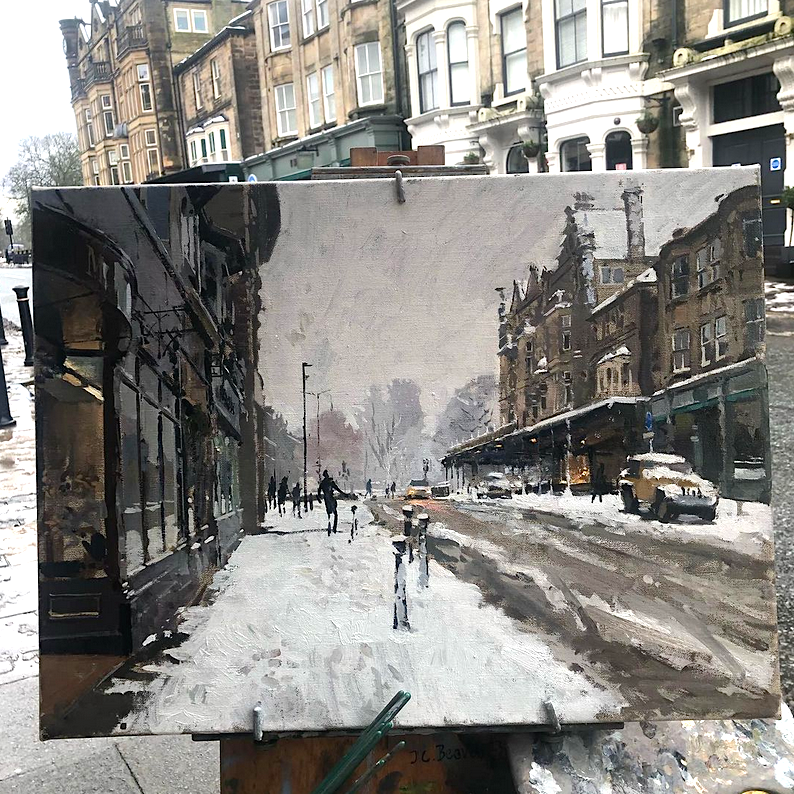
by Peter Brown NEAC
It was not until after Christmas that I realised while flicking through a Messums brochure that my spring show in Harrogate actually opened 5th February. This meant I had 2 weeks to see what I could produce and would need to order frames ahead.
“What time are you leaving in the morning dad?”
“I dunno 4 or something ridiculous”
“If you are staying up all week an hour here or there won’t matter will it?”
From the mouths of 14 year old girls…. When Lisa asked me the same question later that Sunday evening I said “Shortly after I get up whenever that i
I am slowing a bit.. not much.. just a bit. Less 2pm bedtimes. Less 5am rises. I left at 6.30 and arrived in Harrogate at 11am. I had had some pointers from a friend who lived here years ago and a couple of ideas from Johnny Messum. I had done a quick google image of Harrogate which proved heavy on Bettys Tea Rooms and The Victoria Shopping Centre. Google maps informed me this town had at its heart a large green park area called the Stray. I did not know really where it was other than near York maybe and below Durham.
When I got here I drove around the centre, noting the Baths and steep streets pointing into a blinding low sun. I noted how much foot traffic was holding the flow of cars up at the crossing on Royal Parade as people headed into Valley Gardens. Parking at the Montpellier Shopping Centre Car Park I did the same exploration on foot. I was struck by the Victorian feel – the cast iron structures fronting parades of shops the wonderful tool shops such as Arkwrights with their old style graphics advertising ‘Electrical goods’ and ‘Spanners’, “Laddes’ and so on.. It was clearly an affluent town – plenty of designer shops, interior shops, Bespoke Kitchen Shops and a surprising number of commercial art galleries. I had noticed the large semi-detached, detached and terraced houses skirting the centre of the town on my way in. It was clearly also a town reliant on tourists with grand old hotels, numerous restaurants and antique shops. It seemed a thriving town in normal times but now it was one on hold. The posh shops were open and `I am sure Christmas trade would have been good but the town was by no means busy. I guess what you would imagine at the end of the Christmas period but that is usually replaced by sales fever which it was not.
8 x 24 Cambridge Crescent
I was not desperately comfortable driving all this way from tier 3 to tier3 – Would I be welcome? I found my first painting looking across the front of the Yorkshire Hotel at Cambridge Crescent, Parliament St and Bettys. It was a nervous fiddly start lacking confidence and residing in tiny detail. Those paintings finish you off. You fiddle and fiddle and are never happy but determined to break the duck, you work on it for too long and finish exhausted. Kept going by frequent trips to Neros for coffee, I set up a small nocturne looking in the reverse direction from below the obelisk. I had had few interactions but they were encouraging or at least pleasant.
At 8pm we had Boris’ announcement. – Oh god – what to do. Legally nothing had really changed – I was still doing my work and it was essential for me to be here to do it (if I was to paint Harrogate). Johnny texted me. He had rather come round to the idea we should shelve it. If it were to go online as he hinted it could. we now at least had more time. The paintings would not need to be framed so imminently and online never seems to have a real hard deadline – no things to be at a certain place by a certain time. But this was not really the issue. It was more ‘should I do it?’. Is it the right thing to do in terms of our communal fight against this pandemic. The first lockdown I talked it over and over with the family and the next morning declared to 60k followers that PTS was going to remain in his studio. But it was different this time. We are more ‘used to it’. I am isolated when I paint. I will not infect anyone. I am outside and it is essential to my work. So I decided to stay this week and see how it went – to a certain extent see how Harrogate would react.
Tuesday 5th January
I parked the car at Montpellier Shoppers Car Park. I struggled with the App and spoke to a traffic warden. We chatted. I told him what I was doing – what I did.. His reply “But aren’t we on lockdown?’ I explained the ‘essential’ bit but asked what he thought. He shrugged. This was not a good start. Luckily a business owner decided to give the chap both barrels as the council were not offering free parking while they had to lock up their businesses. The town was desolate. I headed off to the bottom of Cornwall Road to paint that delicious curving dipping and rising of Crescent Road and Royal Parade with the Royal Pump room in the fore. I painted with confidence and chatted to locals. They all offered hellos and good mornings and “Aren’t your fingers chilly?”. I am no front line worker but perhaps I could be a small distraction – seeing a scruffy cold grey haired man trying to paint a picture of a street seems to make people smile. Whether it’s a ‘Silly old Fool’ or a ‘Bless him’ or a ‘Good for him’ or as has been voiced quite a bit ‘What a good thing to do during lockdown’, it seemed my fears were perhaps unfounded. Next was looking across the park from Montpellier Hill. – a 30cm x 60cm (Pete goes metric!). A I set up a couple of ‘oil paint beginners’ quizzed me. I explained my view and why I had chosen it. They left and I set to work as dog walkers ‘Good Afternoon’ ‘d me and the odd lone walker stopped for a nose. The groups of teenagers were absent today. You always hear them a mile off and you await the “Hey there’s an artist” before they arrived and you get nosed at and commented on – always polite I have to say. As the afternoon drew on grey turned to winter sun then back to grey and then twilight as runners used the hill for repeated sprints up and recovery jogs back down. The ‘oil paint beginners’ returned and were pleasantly surprised that what I had done resembled the view. I finished the day on an attempted nocturne of the front Betties.
Wenesday 6th January
I stepped out of the hotel to a dusting of snow – “Wonderful” “Help. Which view?”. The van was frozen. I Turned the ignition on and let it run while I got a coffee from Neros. I drove up Cold Bath Road and back down. There were views. Was the sun going to appear? It seemed so. Which view. Any view Pete. It’s all good. The Park! I headed for Valley Gardens, Parking on Valley Drive, I did not scout but committed to every shaped board I could carry and walked in to the park. It was the right choice. The sun did make an appearance but not til late. the Gardens are low and the snow I was painting was untouched by the messy sun! The gardens were quite busy – couples, mums and toddlers, elderly people on constitutionals. They all said good morning and admired the progress.
“oh you are making me feel very guilty”
“I saw you up the top yesterday. I used to do this but have not done it in ages – I’m too scared now. You should brighten the green on the right to give it some depth”
He was an elderly gent with hearing aids. I decided he knew his painting and wanted to share my earlier conversation with a couple who were very complimentary about my painting. I had felt quite warmed by their accolades until they started to enthuse about Bob Ross
“I am hard of hearing I’m afraid”
I spoke louder.
“No not louder. Just clearer”
“Sorry I do mumble”
I mentioned Bob Ross. He laughed but went on to say he did see a bit of him the other day and he thought he was actually quite good.
The painting was done and so was the snow.
I was cold so went for a drive. The only way you can warm up in lockdown – no cafes or bars.
The sun was out. I was surprised how low it was at midday. This is its peak I thought. Navigating the Roundabout of Leeds Road and West Park the view through the trees to Trinity Road of the priory with its lantern tower and Trinity Church winked at me. So I parked up and worked on a 12 x 16. I met Phil who confessed (?) to being a depressant. I don’t know why but I find people who admit to this extremely good to talk to or rather listen to. No memory of what we chatted about but we hit it off.
I was now cold and had another drive, a coffee and a cake. I returned to my first painting and fiddled some more until it was dark. Betties now did not have their lights on so I could not work on the night before (nocturne) pic. I was painting by the van and packed everything away. Looking at the same view again towards the Memorial I got all my stuff out again and attempted a 12 x 16 nocturne attracted by the lit façade of the Yorkshire Hotel. I was cold and tired and should have called it a day. Sometimes I think I cannot see any more!
Thursday 7th
A cold frosty bright morning.
I turned the van on, walked up Cold Bath Street to the bakery for a coffee then drove. I checked out high Harrogate but found it mainly residential and not very unique so, spotting a sign for Knaresborough, set off to check out the viaduct. It was impressive – hidden from the sun it would be icy to paint from the bridge and it would always be there for another day. I wanted to take advantage of this crisp morning. Thinking of viaducts I remembered a conversation I had in Valley Gardens on Tuesday in the snow. The chap told me there was great view of a viaduct in Hornbeam park. So I headed that way. The satnav was taking me to the Railway station. I could see an area of green on google maps next to it and drove alongside in what looked like an industrial estate. Driving to the end of the road I parked in customer parking for one of the businesses and managed to collar a walker returning to his car. He was plugged in to some podcast and although I had interrupted him he was very polite and helpful. My guess as to which way the viaduct would be was completely wrong and he directed me the opposite way. Looking at my shoes he suggested I took the longer route via road rather that direct as it was very muddy. I ignored him. He was right although the mud on the whole was frozen. It was like walking on chocolate crispy cakes. As I entered the wood I asked a dog walker whether I was heading the right way.
”Straight on and you’ll see it. 500 chocolate crispy steps later to my right over a beautiful frosted field licked with pale shadow and peachy morning sun was a long expanse of elegant arches. A draftsmen’s nightmare and something I would usually duck, I told myself I could do it. I did not count the arches relying instead on gut. I did make sure the spacing was even but it was long and the perspective of the arches changed from left to right. I was aware of the frost melting and the light changing and was calm and pragmatic. ‘Don’t stress. Just get on with it Pete’. I was surprised how much I enjoyed trying to get the sheep and also how much they moved as they munched grass rotating like teenagers slow dancing at a disco. There were quite a few walkers with or without dogs on their own or as couples. One was running a virtual race and could not stop. The couple I spoke to as I was packing up pointed me down to the beck (?) for a closer look at the viaduct although they pointed out much to my delight that I had the better view.
The mile or so walk up the path in the now defrosted mud was hard in my twenty odd layers of thermals and I was knackered when I got back to the van. I got a coffee at ‘Indulge’ in one of the units and headed back to town. Parking on Montpellier Hill and after much ruminating I decided to work some more on the 30 x 60 cms of the park with the ice cream hut. I did not like the lime green grass I had painted originally and thought I could get the painting to a more resolved, more ‘real’ level. It was mistier today and the light had now flattened a lot although sun and shadows came and went. I was pleased I had a second go. There was lots more that I noticed and adjusted – tones in particular.
I had some weird Scandinavian lunch of beetroot and potato bravas that relied heavily on the pot of ketchup for its flavour. But it was hot and filling. It was 3 now so dark in an hour and I returned to outside the bank to start a 12 x 16 of Bettys shortly moving on to the nocturne I had started on Tuesday (?). A man started talking to me. I am not sure what he started with but again I realised he knew his painting. Initially annoyed with the interruption I warmed to him. He used to illustrate for the film industry – advertising posters mainly but for his soul. He used to do this a lot. He told me about a trip he did with mates years ago on the East Coast of the U.S. painting and flogging off the easel. He said he wish he had the nerve to do it again and he said I had inspired him to maybe get out there. Empathising with his lack of confidence and explaining how hard it is to start again I said “You know what you have to do don’t you?’ He was nodding in agreement before I had finished “You just have to do it.”
We were joined by a woman with what sounded like an American accent. She was a writer and we drew comparisons between writing and painting and in particular the block. Attention was now moving to her.
“That accent. Are you from America?” said Frank
‘Bradford” she said. We were amazed. She said people often thought that. The reason for her accent she surmised was that she had travelled a lot and also spoke several languages. We quizzed her. She listed 8 and said she was currently learning Arabic as she was becoming a Muslim and wanted to read the Koran in the original.
She wished Frank well in getting back to painting and suggested he go painting with me. I hate it when people do that. Promising my time away for me. She left and we looked at each other stunned “Aren’t some people amazing. What an amazing person!”
We talked a bit longer then Frank left after repeating that I had inspired him.
It dawned on me that perhaps this was something useful I could do. I seem to be stumbling on quite a few people – particularly men late in life, who have or had a talent for painting and are keen to re-engage. It seems this could be my market where `I could make a useful difference’. So that is duly filed in the charity folder for later…
Friday 8th January 2021
I was really looking forward to driving home at the end of today to see the kids and Lisa. I knew it would be a full-on day. Heavy snow/ sleet was forecast. I looked out the window which overlooks a small back yard of the hotel at 7am – the night’s snow had not settled. As I left the hotel an hour later snow had started to fall again. I switched on the van and walked up to the bakery for a coffee and a croissant. Walking back the snow had got heavier but the ground was wet. The van was now toasty and I sat in drinking coffee and scoffing my croissant. The snow got heavier still. The flakes where huge. The snow was winning. Landing rate was beating melting rate and in 20 minutes the snow was 2cm. I decided to drive around looking for best possible view. Big mistake. The snow was getting serious and traffic was struggling to navigate the roads. I abandoned the van on crescent road and headed up Parliament St armed with canvases and boards of all shape. Cars were sliding into each other at the bottom and Parliament street was becoming gridlocked. It did this on and off throughout the day. I found shelter with a view under the awning of a jeweller looking directly at Bettys. I phoned Lisa and asked her to rebook me at the White Hart. I assumed I would not be able to drive out of Harrogate. I have never experienced snow like it. It was consistently heavy all day. I had to paint under shelter or I would not last an hour before everything would be soaked through and useless. I really struggled – nervous and lacking confidence. Everyone was consumed by the snow but if they noticed me they could not resist a peak. As I set up an elderly man in an electric mobility scooter looked at me and declared ‘Bloody Hell!”. I laughed not knowing if he was cross or just a bit of a card. He passed again a few minutes later and it turned out I did make him cross for some reason. Perhaps he was struggling in this awful stuff yet I was treating it as a bit of fun? Later on a man called Mark struck up conversation. He lives in a chapel he had converted in Harrogate. I imagine anyone from Harrogate reading this would now know who I meant. We seemed to agree on most things art. Both obsessed with paintings and the need to acquire them although it seems he has the means, is more ambitious, Fanatical and his taste is more eclectic than mine. Another couple he knew pulled him away from me although they included me in their chat. The second man had just bought (well the development company he worked for) an impressive grade 1 building in an industrial estate in Leeds which they were making good for the British Library to the tune of £75million. They eventually left. Mark remained. I had to keep making the point of trying to look around him as he kept blocking my view so ‘into’ our conversation as he was. He left after us exchanging numbers and him insisting I come round for a nose a chat and a bottle of wine. OMG how I’d love that. I returned to the hotel later to a DM from hin confirming the offer which I ducked. Rules is rules. It will have to wait until spring. I’d started this painting at 8.30 and as I was packing up a lady asked how long I’d been painting it.. ”What’s the time?” “2pm”. “Christ. Have I been painting that long?”. I panicked. It’ll be dark soon.
I headed to the Betties awning. The view back to where I had been was good but the on and off grid locked Parliament Street meant I could well be looking at the side of a van for the most part. I found a view under another cast iron awning a little further down Parliament St and on the other side. Again I was looking back at Bettys but with a much more interesting perspective up the hill. I continued to struggle with the pale greys and was frustrated by the view being constantly blocked by delivery vans and trucks. The linguist from the day before spotted me but I was grumpy and gave her short shrift. She said she would buy one but her place was more Morocco really. As it inevitably got dark sooner than I wanted I rotated and tried a view down into the melee of purple snow on the rooftops of the buildings on the rising hill from the bottom of Parliament Street. An opticians threw peachy light across the snow in the foreground and the view was framed with some cast iron work of the awning. I pushed it further than I would normally these ‘end of the day’ ones even though I was knackered. Usually these paintings get abandoned and left unfinished. This one felt close to resolution.
It had been a long hard day. I managed to move the van from its parking spot surrounded by a foot of snow and drove round town trying to work out where would be best to leave it as we expect a big freeze tonight. Driving up Cold Bath Road I was managing until I had to come to a rest behind a Seat that was being pushed by three men. They got it going and then they came to help me. One played foreman and he knew what he was about. The 3 tonne van had more traction. As I got purchase I tooted a thank you and drove on up passing the Seat that was now in more trouble. I eventually settled on leaving it on West Park giving me the more likely better option of Parliament Street but also Montpellier Hill.
I ordered a click n collect wagamamas, crunched through the snow to the hotel and checked in at which point I stopped feeling sorry for myself. ‘We’re busy tonight sir. Most of Harrogate Hospital are here as they could not get home. Today’s Covid death toll is the largest it has been at 1,325 with 69,025 people testing positive. Tomorrow we have -2c and sun so the snow will remain I imagine through Sunday and Monday which is overcast. It looks like I will head for home Monday night.
Today I let it feel like work. I am a twat. Tomorrow I shall relish it!
Saturday 9th January
12 x 16 West Park. Tree limbs laden with lilac snow against ochre viridian sky. As sun rose chunks of melted icy snow fell on me and pallet.
10 x 12 Tree in Snow and sun. Keeping it chill Crossed road and painted just some light on snow
Sun weakened to a light I prefer.
30 x 60cms Waking on the Stray, Snow. 2 pairs boots swapping for warm pair from the windscreen van heater.
18 x 24 ? second go as sun was lowering – Bettys from Parliament st
16 x 12. Twilight snow Parliament Street.
Lisa booked me in for another night as snow was still deep on the stray and my view is it will be here til Monday afternoon.
Sunday 10th January
It was thawing. The roads were now black and trees had shed all their snow and were now just sodden. The stray was still covered as was the ungritted pavements and the awning of Bettys but it lay in patches on roof tops.
I revisited ‘Bettys from Parliament’ St 18 x 24 inches now with no queuing cars in front. But I mainly concentrated on the left façade which I had ignored the day before. The painted shop fronts and windows reflecting grey sky and white snow it was a treat to paint. Couples on a Sunday morning stroll greeted me.
“Ah! It’s Pete-the-Street. We’ve been reading about you. You’re all over social media.”
Fame at last mother!
12 x 16 ‘Bettys, Thaw’
I had an idea that the grey ‘moving towards twilight’ painting I had started of Bettys from the bank could convert well to the thawing snow. I nipped up the street to confirm and went and grabbed it from the van. It was the last painting I would work on for this trip and I was comfortable driving away knowing I’d got the good stuff. I was pleased to see the surrounding countryside on the way to Wetherby and beyond was devoid of snow drift and stunning white rolling landscapes. I was a bit shagged out and just wanted to listen to my audio book and drive home.
Thursday 14th January
I dropped Ollie back at Durham on the Wednesday and headed down to Harrogate to meet Tony the Yorkshire Post photographer. I was booked in to the White Hart Wednesday night and Thursday it seemed Harrogate was doing its snow thing again:
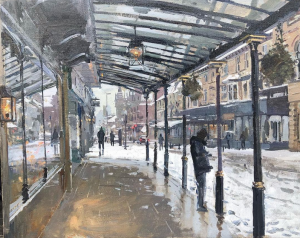 8.30am – 1pm ‘Down Parliament Street from under the Bettys awning’ 16 x 20 (pictured right)
8.30am – 1pm ‘Down Parliament Street from under the Bettys awning’ 16 x 20 (pictured right)
1.30pm – 4.30pm “West Park from Bettys, Snow’
The glowing window display of the Bettys fought with the reflection of the white snow across Parliament Street’s pavement and road. Harrogate was very quiet. Behind me a homeless man was sitting under a red brolly. Over the morning 2 or 3 customers knocked on the Bettys door to collect an order and a handful of people walked by as well as 2 gritters and 3 snow ploughs .. oh and of course the odd runner. They are mad on running here. They’ll run in anything, over anything, precariously slipping up and down hills on icy rutted snow and in biting winds. A young couple appeared from below at one point – barring their pink glistening legs they were covered head to toe in the snow they had been running into. They seemed to be perfectly happy! After a while joining the brolly man and I were joined by two gentlemen. One of them offered his friend, the chap under the brolly and me a coffee. He took the orders and returned from Neros with hot drinks for us all. The two friends then immersed themselves in serious conversation about erecting shelves, their wives habits, weekly shopping and other things.. I did not notice them leave. The homeless man had now been joined by a young woman and they were gassing with as much gusto as the previous two. I painted til 1pm and then starving offered the brolly man a coffee. I returned to finish the painting off. Brolly man had noe left his corner and it offered me a good sheltered spot with a view down West Park at oncoming warm car headlights. I painted here on a 16 x 20 until it was too dark.
16 x 12 Twilight Snow, Parliament Street
Twilight is both longer and more enticing. The view down Parliament Street from the other side of the road was fantastic.: A jeweller or optician spilling bright light across the snow, the Skipton Road melting into the sky in the background, even the warm glow of the top floor lights in the 60’s office block on the left looked yummy so I dumped the 2 previous canvases back at the van and returned with a 16 x 12 board. I set up under a bright white streetlight. Unfortunately, however it was still snowing, and I remembered the value of shelter as I pushed oil paint and ice crystals around a piece of MDF for an hour or so. Ruby from the post phoned as I was walking back to the van. I said I’d ring her back when I was somewhere warmer. I sorted the paintings back at the van stripping my wet let layers while catching the ever more depressing 6 O’Clock News then checked back into the hotel where Lisa had booked me another night. I ordered room service – a samosa and an aubergine curry and phoned Ruby. The room was warm. My back ached but I quite liked it. Tomorrow would be bright sunny and icy…
Peter’s exhibition of Harrogate paintings opens at Messums Yorkshire on Saturday 20 March 2021
Register interest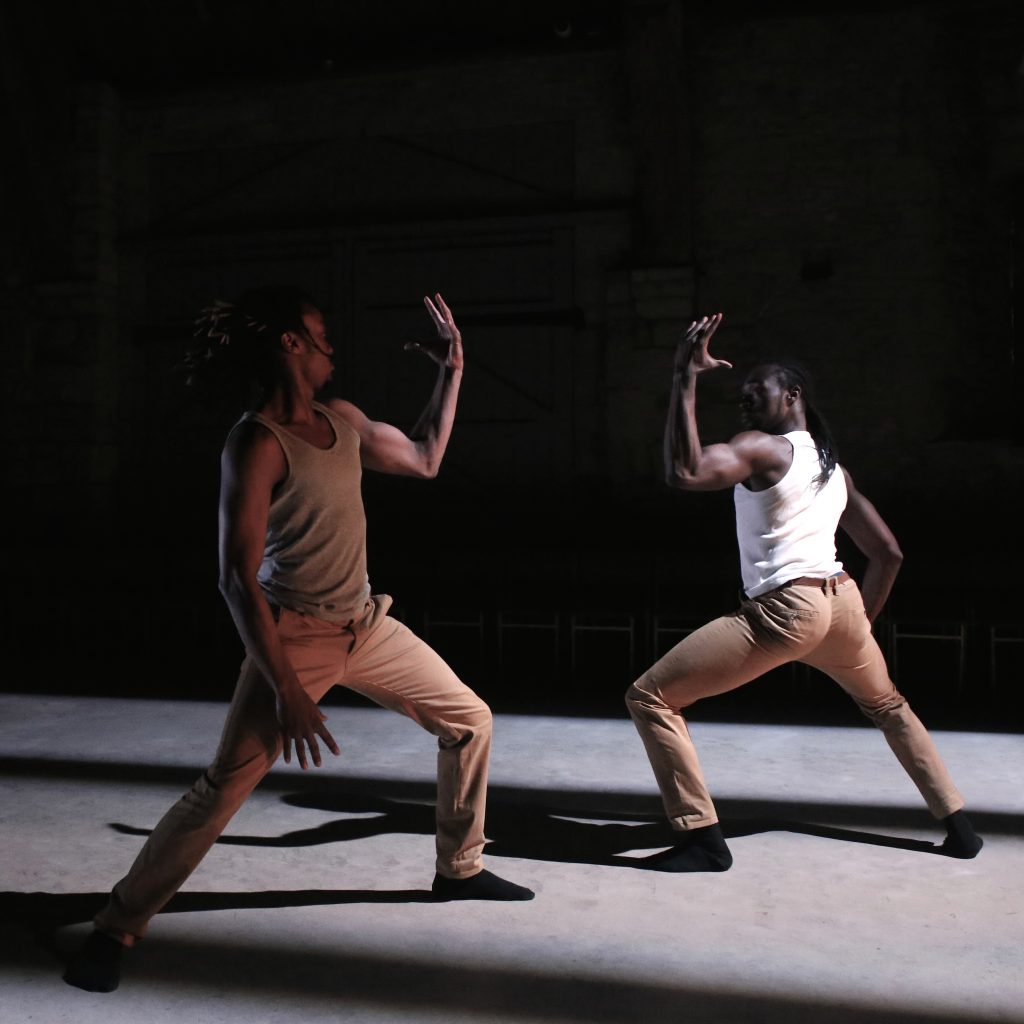
Performance Associate Anthony Matsena talks to Messums Wiltshire about Co-directing, choreographing and performing in lock down alongside his brother Kel and his plans for creating a film and live performance coming to Messums Wiltshire this September.
It has been an incredible year for Anthony Matsena. Following his sell-out performances here at the barn gallery, Anthony has been busy working on projects for the National Dance Company Wales and a brand new piece commissioned by Messums Wiltshire in response to the Elisabeth Frink studio – in situ at the gallery from Saturday 4 July. As with all our events at this time, the dance will now be performed online but Anthony will be here to introduce it to us ahead of time via Zoom.
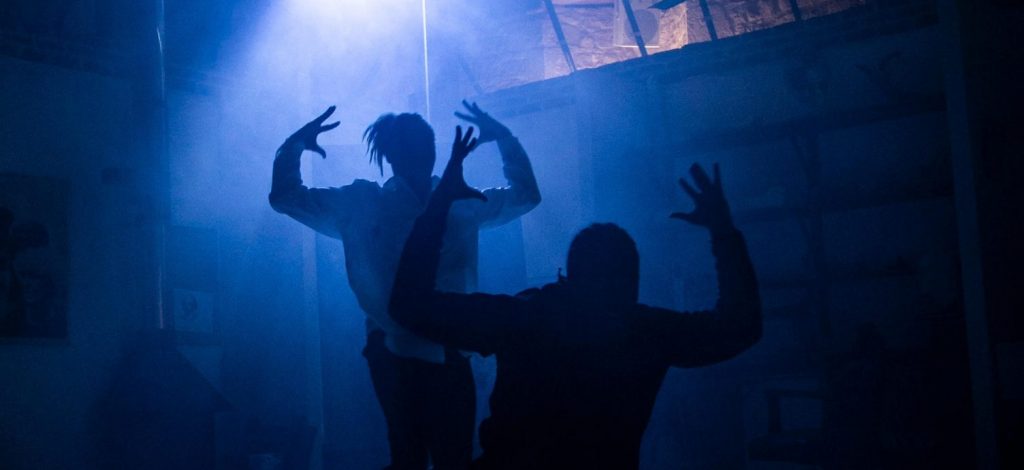
Live Performance: Saturday 5 September – SOLD OUT
Online Screening: Saturday 5 September – Tickets Launched
channelling three distinct camera angles the performance
will be live streamed to an online audience
Full price – £16.50
Members price – £6.50
Discount for members using access code
A ground breaking synthesis of performance and art in the recreated studio of Elisabeth Frink. Set within the largest thatched building in the country, this one off performance production is created in response to these challenging and creatively vital times. A synthesis of the legacy and output of Frink, the repercussions of COVID-19 and the Black Lives Matter movement forms the basis of this pioneering contemporary dance performance.
Matsena Performance Theatre is Anthony and Kel Matsena – Zimbabwean born and Welsh raised brothers. Through their experience of being brought up in an Afrocentric house and having Eurocentric schooling, they have built a love and curiosity for telling stories that express themes of culture, race, change and belonging. These two incredibly talented young brothers are adding their voices to a movement that included mass uprising, civil unrest and cries to stay connected and not numb to the world around them.
Referring to both the global pandemic and the numerous cases of injustice and conflict around the world Anthony says, ‘there has been a whole lot of loss and an insurmountable amount of fear that’s crept up in people’s lives and it’s become normal which is frightening… that I see people’s lives being lost as numbers or statistics.. that worries me.’ The Title behind the live and online performance is the unsettling question ‘are you numb yet?’ Kel astutely discusses this discomforting phenomenon of instant global news, where information overload means that although ‘the news of last week is extreme […] it’s still last week’s news’. Very few artists and performers are successfully dealing with these unsettling notions and the sudden awareness of how race has been a blinding problem for so many.
In many ways the natural medium with which to have these conversations is through the arts and very particularly live performance. Anthony points out that there is a parallel between life and live performance that does not occur in other art forms. ‘I like the high stakes of theatre.. if the magic of coping with what goes wrong is relevant to our lives then time is linear. Life is about coping with whatever happens, sometimes in theatre something falls.. a light goes.. someone feints. you deal with it and still perform.. and that part of it.. that’s the magic for me.’
The realisation is so recent in our history that we are still grappling with the language with which to discuss it. Kel and Anthony are not here to raise their voices, the performance is powerful embodiment of a language that does far more and asks the question about being alive to others concerns.
The title “ Geometry of Fear” was conceived by Art critic Herbert Read and refers to a phase of British figurative sculpture expressing post-war anxieties. Dame Elisabeth Frink, a child of her time and much affected by growing up during the war embodied these sculptors’ work and aspirations. These visceral and tortured looking sculptures caught Frinks wider interest in the Human condition and the language of sculpture that Frink inhabited. Frink’s goggle heads are perhaps most representative of her work and preoccupation with the inhumanity inherent in the blank and unapproachable archetype of power personified by the male figure. The goggles are polished, reflecting back any scrutiny, any chance at a mutual exchange. They could be seen as a political or institutional body, and are every cruel act anonymously hidden behind the term ‘they’ where power is so often abused. In the words of Elisabeth Frink, ‘we no longer respond properly to atrocities, if I had a religion it is that every man should be free in his spirit’. With the performance happening in and around the actual building that Frink created her sculptures, the parallels across time and artist cannot be ignored. As Anthony says, ‘fairness and equality should be the standard and it’s never been’. Put simply by Kel, ‘if we believe in equality, we have to fight for it.’
‘Finally, people are having conversations that should have been had centuries ago but there is uncertainty about how we deal with those conversations.’
Kel Matsena
‘We cant do a lot but we can use what we have and that’s our art, to try and affect change.’
Anthony Matsena
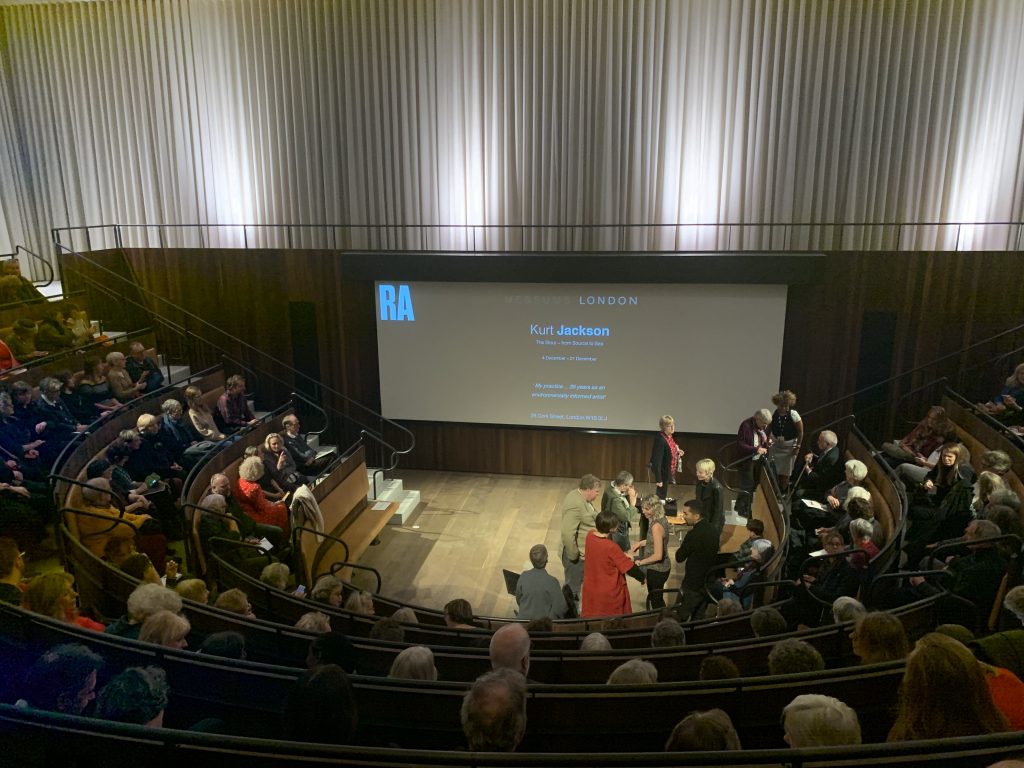
An exhibition of new paintings by Kurt Jackson opened last week with great excitement. ‘My Father’s River’ traces Kurt’s journey along the River Stour in East Anglia.
The day began with a packed curator’s tour of ‘My Father’s River’ led by Johnny Messum, before moving to the Royal Academy Lecture Theatre where Kurt spoke to over 300 people about his work both as an artist and an environmentalist. He talked through the major projects that have come to define his practice as an environmentally informed artist.
His residency aboard the Greenpeace ship Esperanza was described in vivid detail alongside excerpts from a BBC documentary.A clip of Greenpeace activists attempting to document damaging fishing practices on a small rib in rough seas while Kurt is continually drawing, documenting the action around him encapsulates his determination and versatility as a painter.
This versatility was also apparent in Kurt’s long stint as artist-in-residence at Glastonbury Festival. The rapid brushstrokes that usually describe the natural landscape were now applied to vast crowds and wild performances. Kurt is clearly a polymath; from designing trophies for environmental awards, working in bronze, pewter and a more recent foray into glass, his enthusiasm for making was increasingly evident.
For most of the talk however Kurt discussed the landscape painting for which he is most well known. That Kurt’s paintings so energetically and vividly evoke these landscapes is less surprising after seeing footage of him painting outside in the elements, canvas spread out on the beach. He gave real insight to the excitement and love of nature behind his works – from protected and fragile environments of rich biodiversity to patches of grass by service stations.
After the talk, a crowd headed towards Messums London for mulled cider and mince pies surrounded by Kurt’s magnificent paintings. Beginning at the river’s source on Wratting Common in Cambridgeshire, the paintings document the river as it winds through the East Anglian countryside, along the border of Suffolk and Essex to where it meets the North Sea at Harwich.
Kurt often painted the Stour with his father who lived by the river for three decades, swimming in it every day. In this body of work, Kurt has rediscovered the river that was so important to his father as well as capturing a fragile and varied landscape with the eye of a keen environmentalist.
‘Source to Sea’, or ‘My Father’s River’, is on show at Messums London until 21st December, followed by exhibition of new works following the Fonthill Brook and River Nadder at Messums Wiltshire. ‘Fonthill Brook’ opens in the Long Gallery at Messums Wiltshire 10 January – 16 February 2020.
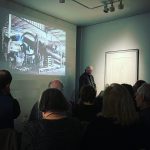
ARTIST’S TALK: 27 & 28 November 2019
Albert Paley’s talk and slide show at Messums London traced the 50 years that he has been working in metal; from making intricate pieces of gold and silver jewellery measured in centimetres to sculptures the size of houses, 30 feet high.
At the root of all his designs are his drawings in pencil he said, that fill the drawers and sketchbooks of his 50,000 square foot studio in Rochester, New York. ‘Drawing is fundamental – it gives you a vocabulary so you can understand what you see,’ he said, adding that his jewellery expressed ‘an attention to detail, a refinement of line.’
Thinking through doing is how he works he says, and as his technical skill has grown so has the ambition of his sculptures. ‘Technique is a way to manage thought development; I don’t know what I’m doing until I start working,’ he explained.
Born in Philadelphia, Paley attended the Tyler School of Art where his earliest works were direct carvings in wood and stone in the tradition of Henry Moore and Barbara Hepworth and he showed us a picture of a delicate, sensuous Rodin-esque sculpture of a woman he carved out of white marble.
Paley’s training was not only manual but academic with an education in the techniques of Renaissance masters like Cellini, Leonardo and Michelangelo as well as the Mannerist and Viennese Secessionist painters of which he is particularly fond.
Early in his career Paley had imagined he would be a goldsmith ‘for the rest of my life,’ but irked by the perception of jewellery as a ‘minor art, rather than what it truly is – a fine art,’ he started making bigger pieces starting with a set of enormous gates facing the White House.
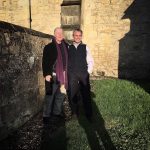
Albert with Johnny Messum at Messums Wiltshire
‘Using metal is like drawing in space’ he said. ‘Punching, ribboning and blasting, the gates enriched my public exposure and allowed me to interface with architecture, pushing me into a new arena’ he said. Going through gates is an act of passage, he said, ‘they are ceremonial archways.’
Consistently throughout all his work appear flowing, sinuous, natural forms – in particular vegetation – within ordered, mathematical structures.
‘My design philosophy is organicity in that one line begets another whether it is in metal or any other material,’ he says.
In 1979, Paley was asked to make two gates for the antechamber of the New York Senate. The Albany gates, as they are known, reflected the nascent fear of terrorism in public spaces in their spiky, thorn-like design protecting the heart of government.
In his talk, Paley rattled through an astonishing array of gates and fences, benches and grills and freestanding ‘sentinels’ or sculptures that he had made, all created with an unerring sense for form and each bigger than the last. He describes his studio as his sanctuary adding that his 16 staff were like the members of an orchestra of which he is the composer.
Paley said he tried to use design to bring a sense of modernity into historic spaces and talked much about the play of light and shade in his work and the beauty of rustification.
The Fence of the Hunter Museum is one of Paley’s wildest works to date where the lines of metal seem to hover in space like banners or whips.
In his recent works, Paley has tended increasingly to paint metal and patinate it in a range of hues.
‘Colour solicits emotion’ he said. ‘Shadows are beautiful but ephemeral and colour adds into that.’
Pointing to a range of eight sculptures he made to adorn the staircase of the Wortham Center for the Performing Arts in Houston, he said the effect was to create ‘a whole sensuality of folded metal, play of light and tromp l’oeil.’
The talk ended with a description of how Paley created the gates for St Louis Zoo, and we saw a fine picture of him next to a metal rhinoceros he had made.
In a question and answer session after his talk somebody in the audience mentioned that the computer has led to the dematerialisation of form and that the importance of objects in the realm of fine art is in a state of flux.
‘Fundamentally, art deals with the human condition’ replied Paley, ‘whether it’s a personal response in canvas or in the public arena like the music of Wagner. Metal articulates emotion beautifully; there is an honesty and integrity to being a blacksmith. It’s all about sharing that language.’
Albert Paley’s talk was part of his exhibition ‘Drawings and Sculptures’ at Messums London which comprised of his architectural two-dimensional works and smaller scale sculptures and maquettes. An exhibition of Albert’s ‘Large Sculptures and Architectural Works’ including examples of his monumental gates, will be open at Messums Wiltshire 4 July – 30 August 2020.
Press coverage:
Financial Times – How to Spend It ‘Mind-blowing Metalwork at Messums London’
Artlyst ‘Three London Shows November 2019’
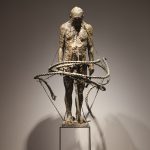
Laurence Edwards’s work has found its way into stately homes, public parks and domestic spaces. The versatility of environment that his work has thrived in showcases its ability to own the space around it, no matter how vast or small, domestic or wild. The difference between a thirteenth century tithe barn in Wiltshire and a Mayfair gallery might be boundless but the striking and enigmatic figures of Laurence Edwards populate both spaces with an atmosphere of mysterious omniscience.
The variability, however, between the individual pieces is exemplified by their curated groupings and placings. The collection of works in Wiltshire for example demand more from their space. Their volumous and shadowy stature possess their own kind of gravity while the pieces in London are preoccupied by more delicate forces; reflection, balance and line.
Wiltshire – Volume
Perhaps the first impression one might get from walking into the Barn and finding yourself amongst these towering characters is the effect of their scale. Not only scale in relation to the building or even to each other but to the viewer. One is confronted by the uneasy feeling of being looked down on from a height or the humbling experience of being eye to eye with a bust larger and taller than oneself. The lofty ceilinged space gives a sense of cathedral-esk verticality that lends a biblical tone to the weighty subjects.
London – Line
The preoccupations inherent in the pieces in Cork St are less to do with volume and more to do with tensions and forces such as that of rope, ties and supports. They elicit notions of the push and pull of encasement and a desire to break free, or the heaviness of the burden many of them carry. Often they suggest some conflict with visible outer forces and often invisible inner forces pertaining to the male psyche. Whatever their struggle these pieces are created with a lighter hand, they are the drawn line solidified in bronze.
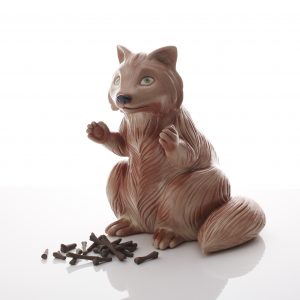
Following an outstanding opening of Malene’s work in Cork St, Malene Hartmann Rasmusen’s exhibition ‘Fantasma’ has relocated itself to Istanbul to be part of ‘Beyond the vessel: Myth and Metamorphosis in Contemporary Ceramics’.
It is too often the case that provincial artists (responding to their own culture or the mythologies of their own community) have to enter main, often western, centers of the world in order to make their name. The koc foundation in Istanbul is upending this. This exhibition looks decidedly outward and pays particular attention of the mythologies of different communities while highlighting the unifying quality of the ancient medium of clay itself.
Malene has drawn inspiration from the cultural outpourings of Scandinavia and her own past. Her work itself is very much responding to a journey that she is on and we are delighted to play a part in the physical journey of these works from Denmark to London and to Istanbul.
Shortly prior to exhibiting in Messums London Malene completed a ceramics residency at the V&A which has informed the works on show.